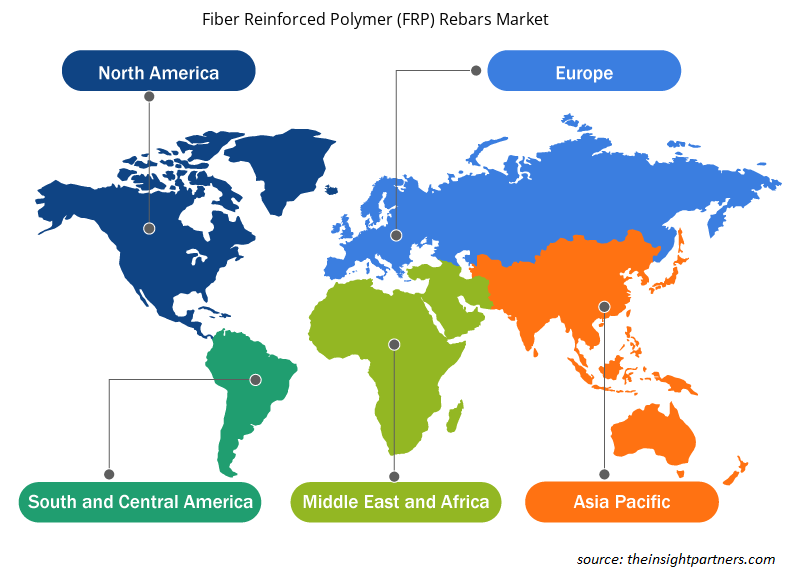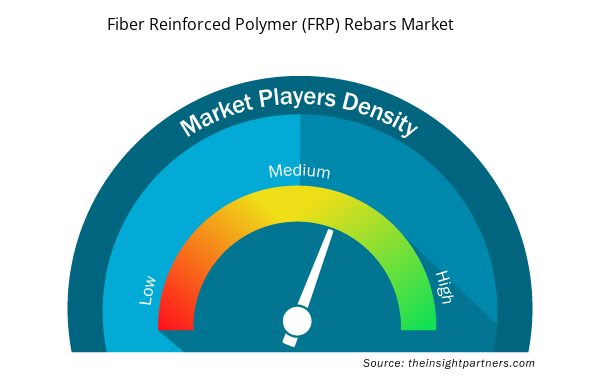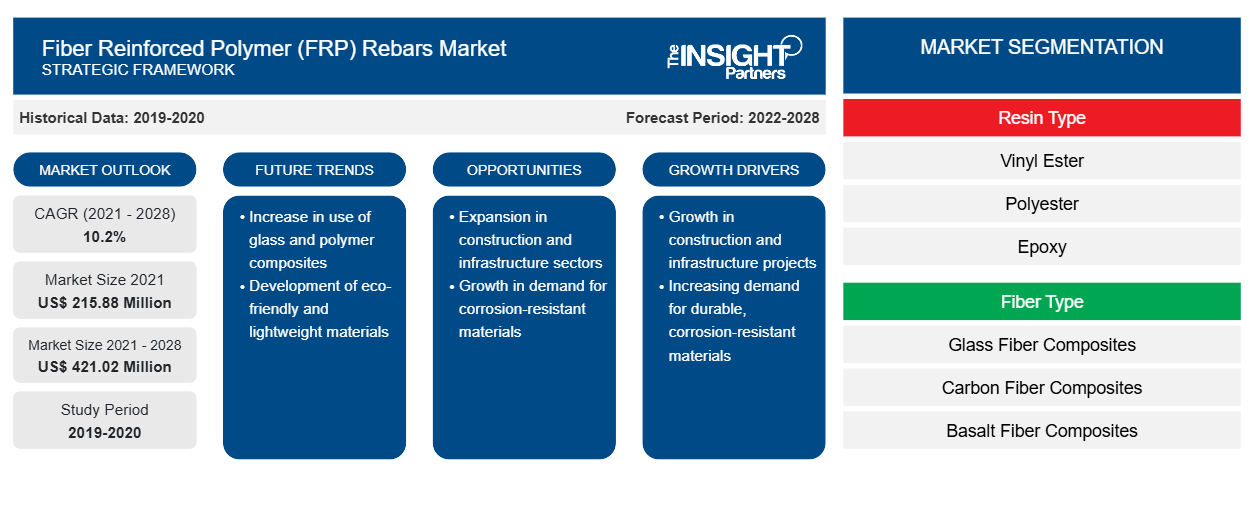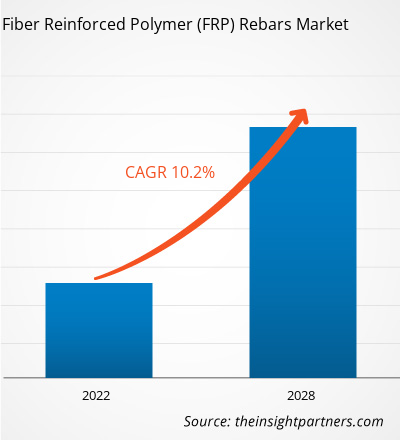Si prevede che il mercato delle barre d'armatura in polimero rinforzato con fibre (FRP) crescerà da 215,88 milioni di dollari nel 2021 a 421,02 milioni di dollari entro il 2028; si stima che crescerà a un CAGR del 10,2% dal 2022 al 2028.
Poiché il calcestruzzo è resistente alla compressione e debole alla tensione, viene in genere rinforzato per creare un materiale da costruzione resistente alla tensione e alla compressione. Questo rinforzo è convenzionalmente costituito da acciaio per il suo basso costo, l'elevata resistenza e l'elevata elasticità. Tuttavia, la corrosione dell'acciaio potrebbe costare ai governi e ai proprietari di asset miliardi di dollari in costi di manutenzione per sostituire o riparare infrastrutture obsolete. Esistono poche alternative per i materiali di rinforzo del calcestruzzo che possono essere utilizzate per prevenire la corrosione. Ad esempio, alcuni produttori offrono barre di armatura in acciaio inossidabile; tuttavia, le barre di armatura in polimero rinforzate con fibre possono fungere da alternativa non corrosiva alle barre di armatura in acciaio convenzionali per il rinforzo del calcestruzzo. Queste barre di armatura FRP sono realizzate con la combinazione di matrice polimerica con fibre di vetro, carbonio o basalto. Questi materiali non arrugginiscono, sono molto più leggeri dell'acciaio, non trasmettono calore e sono quasi quattro volte più resistenti alla tensione. La capacità anticorrosione rende il polimero rinforzato con fibre la migliore alternativa per varie applicazioni edilizie, come muri di contenimento, moli, banchine, cassoni, ponti, paratie, palificazioni, canali, piattaforme offshore, piscine e acquari.
Inoltre, nelle applicazioni sensibili alle interferenze elettromagnetiche, le proprietà non conduttive del vetro e del polimero delle barre di rinforzo in FRP non trasmettono corrente, non attraggono fulmini e non interferiscono con il funzionamento di dispositivi elettrici nelle vicinanze. Ciò rende il polimero rinforzato con fibre un'alternativa più sicura all'acciaio negli impianti di fusione di alluminio e rame, nelle torri aeroportuali, nelle centrali nucleari, nelle strutture militari specializzate, nelle torri di trasmissione elettrica e telefonica, nei tombini contenenti apparecchiature elettriche o telefoniche e negli ospedali dotati di apparecchiature per la risonanza magnetica (MRI).
Personalizza questo report in base alle tue esigenze
Riceverai la personalizzazione gratuita di qualsiasi report, comprese parti di questo report, o analisi a livello nazionale, pacchetto dati Excel, oltre a usufruire di grandi offerte e sconti per start-up e università
- Scopri le principali tendenze di mercato in questo rapporto.Questo campione GRATUITO includerà analisi di dati che spaziano dalle tendenze di mercato alle stime e alle previsioni.
Approfondimenti di mercato
Le crescenti attività di costruzione stimolano la crescita del mercato delle barre d'armatura in polimero rinforzato con fibre (FRP)
Il settore delle costruzioni è uno dei principali fattori che contribuiscono allo sviluppo economico in tutto il mondo. Sta prosperando rapidamente grazie al crescente sostegno governativo allo sviluppo delle infrastrutture in tutto il mondo. Ad esempio, l'India ha pianificato di spendere 1,4 trilioni di dollari USA in infrastrutture attraverso la National Infrastructure Pipeline dal 2019 al 2023. In questa pipeline, il governo ha incluso infrastrutture come energia, ponti, dighe, strade e sviluppo di infrastrutture urbane. Grazie alle loro vantaggiose proprietà dei materiali come elevata resistenza, tolleranza al gelo e ai sali antighiaccio e brevi tempi di installazione con minima interferenza del traffico, i polimeri rinforzati con fibre sono maturati fino a diventare preziosi materiali da costruzione sostitutivi per le strutture dei ponti. Si prevede che tali iniziative dei governi di diversi paesi stimoleranno la crescita del mercato delle barre di armatura in polimeri rinforzati con fibre (FRP)
Informazioni sul tipo di resina
In base al tipo di resina, il mercato globale delle barre d'armatura in polimero rinforzato con fibre (FRP) è suddiviso in vinilestere, poliestere, epossidico e altri. Nel 2021, il segmento vinilestere deteneva la quota di mercato maggiore. Le resine vinilestere hanno elevata resistenza; elevata resistenza alla corrosione, ai carburanti, alle sostanze chimiche o ai vapori; e offrono tenacità meccanica. Hanno grande durata, resistenza al calore e elevata resistenza all'allungamento alla trazione. Questa resina può essere impregnata con fibra di vetro corta o fibra di carbonio per produrre barre d'armatura in FRP. La maggior parte dei produttori di barre d'armatura in polimero rinforzato con fibre utilizza resina vinilestere. La convenienza del vinilestere ha stimolato la crescita del segmento.
Owens Corning; KODIAC Fiberglass Rebar; MARSHALL COMPOSITE TECHNOLOGIES, LLC; TUF-BAR; Armastek USA; Pultron Composites; FiRep Inc.; PULTRALL, Inc.; Schock Bauteile GmbH; e Dextra Group sono tra i principali attori che operano nel mercato globale delle barre di armatura in polimero rinforzato con fibra di vetro (FRP). I principali attori adottano strategie come fusioni e acquisizioni e lanci di prodotti per espandere la loro presenza geografica e la loro clientela. Ad esempio, Pultron Composites ha stabilito una partnership con Saudi Aramco, la principale compagnia petrolifera saudita, per aumentare i suoi impianti di produzione di barre di armatura in polimero rinforzato con fibra di vetro (GFRP) nel paese.
Barre di rinforzo in polimero FRP rinforzate con fibre
Approfondimenti regionali sul mercato delle barre d'armatura in polimero rinforzato con fibre (FRP)
Le tendenze regionali e i fattori che influenzano il mercato delle barre d'armatura in polimero rinforzato con fibre (FRP) durante il periodo di previsione sono stati ampiamente spiegati dagli analisti di Insight Partners. Questa sezione discute anche i segmenti e la geografia del mercato delle barre d'armatura in polimero rinforzato con fibre (FRP) in Nord America, Europa, Asia Pacifico, Medio Oriente e Africa e America meridionale e centrale.

- Ottieni i dati specifici regionali per il mercato delle barre d'armatura in polimero rinforzato con fibre (FRP)
Ambito del rapporto di mercato sulle barre d'armatura in polimero rinforzato con fibre (FRP)
| Attributo del report | Dettagli |
|---|---|
| Dimensioni del mercato nel 2021 | 215,88 milioni di dollari USA |
| Dimensioni del mercato entro il 2028 | 421,02 milioni di dollari USA |
| CAGR globale (2021 - 2028) | 10,2% |
| Dati storici | 2019-2020 |
| Periodo di previsione | 2022-2028 |
| Segmenti coperti | Per tipo di resina
|
| Regioni e Paesi coperti | America del Nord
|
| Leader di mercato e profili aziendali chiave |
|
Densità degli attori del mercato delle barre d'armatura in polimero rinforzato con fibre (FRP): comprendere il suo impatto sulle dinamiche aziendali
Il mercato delle barre d'armatura in polimero rinforzato con fibre (FRP) sta crescendo rapidamente, spinto dalla crescente domanda degli utenti finali dovuta a fattori quali l'evoluzione delle preferenze dei consumatori, i progressi tecnologici e una maggiore consapevolezza dei vantaggi del prodotto. Con l'aumento della domanda, le aziende stanno ampliando la propria offerta, innovando per soddisfare le esigenze dei consumatori e capitalizzando sulle tendenze emergenti, il che alimenta ulteriormente la crescita del mercato.
La densità degli operatori di mercato si riferisce alla distribuzione di aziende o società che operano in un particolare mercato o settore. Indica quanti concorrenti (operatori di mercato) sono presenti in un dato spazio di mercato in relazione alle sue dimensioni o al valore di mercato totale.
Le principali aziende che operano nel mercato delle barre d'armatura in polimero rinforzato con fibre (FRP) sono:
- Owens Corning
- Barre di rinforzo in fibra di vetro KODIAC
- TECNOLOGIE COMPOSITE MARSHALL, LLC.
- BARRA TUF
- Armastek USA
Disclaimer : le aziende elencate sopra non sono classificate secondo un ordine particolare.

- Ottieni una panoramica dei principali attori del mercato delle barre d'armatura in polimero rinforzato con fibre (FRP)
Segnala i riflettori
- Tendenze progressive nel settore delle barre d'armatura in polimero rinforzato con fibre (FRP) per aiutare gli operatori a sviluppare strategie efficaci a lungo termine
- Strategie di crescita aziendale adottate dalle aziende per garantire la crescita nei mercati sviluppati e in via di sviluppo
- Analisi quantitativa del mercato globale delle barre d'armatura in polimero rinforzato con fibre (FRP) dal 2022 al 2028
- Stima della domanda di barre d'armatura in polimero rinforzato con fibre (FRP)
- Analisi di Porter per illustrare l'efficacia degli acquirenti e dei fornitori che operano nel settore nel prevedere la crescita del mercato
- Sviluppi recenti per comprendere lo scenario competitivo del mercato e la domanda di barre d'armatura in polimero rinforzato con fibre (FRP)
- Tendenze e prospettive di mercato, e fattori che guidano e frenano la crescita del mercato globale delle barre d'armatura in polimero rinforzato con fibre (FRP)
- Comprendere le strategie che sostengono l'interesse commerciale per quanto riguarda la crescita del mercato globale delle barre d'armatura in polimero rinforzato con fibre (FRP), aiutando nel processo decisionale
- Dimensioni del mercato globale delle barre d'armatura in polimero rinforzato con fibre (FRP) in vari nodi di mercato
- Panoramica dettagliata e segmentazione del mercato globale delle barre d'armatura in polimero rinforzato con fibre (FRP) e delle sue dinamiche di settore
- Dimensioni del mercato globale delle barre d'armatura in polimero rinforzato con fibre (FRP) in varie regioni con promettenti opportunità di crescita
"Analisi del mercato delle barre d'armatura in polimero rinforzato con fibre (FRP) fino al 2028" è uno studio specializzato e approfondito del settore chimico e dei materiali, incentrato sull'analisi delle tendenze del mercato delle barre d'armatura in polimero rinforzato con fibre (FRP). Il rapporto mira a fornire una panoramica del mercato con una segmentazione dettagliata. Il mercato delle barre d'armatura in polimero rinforzato con fibre (FRP) è suddiviso in tipo di resina, tipo di fibra, applicazione e area geografica. In base al tipo di resina, il mercato è suddiviso in vinilestere, poliestere, epossidico e altri. In base al tipo di fibra, il mercato è suddiviso in compositi in fibra di vetro, compositi in fibra di carbonio e compositi in fibra di basalto. In base all'applicazione, il mercato è suddiviso in ponti e costruzioni autostradali, strutture marine e litorali, impianti di trattamento delle acque e altri. In base all'area geografica, il mercato è suddiviso in cinque regioni principali: Nord America, Europa, Asia Pacifico, Medio Oriente e Africa e Sud e Centro America. Nel 2021, il Nord America ha dominato il mercato delle barre d'armatura in polimero rinforzato con fibre (FRP). Tuttavia, si prevede che la regione Asia-Pacifico registrerà il CAGR più elevato del mercato durante il periodo di previsione.
- Analisi storica (2 anni), anno base, previsione (7 anni) con CAGR
- Analisi PEST e SWOT
- Valore/volume delle dimensioni del mercato - Globale, regionale, nazionale
- Industria e panorama competitivo
- Set di dati Excel



Report Coverage
Revenue forecast, Company Analysis, Industry landscape, Growth factors, and Trends

Segment Covered
This text is related
to segments covered.

Regional Scope
North America, Europe, Asia Pacific, Middle East & Africa, South & Central America

Country Scope
This text is related
to country scope.
Domande frequenti
In 2021, North America accounted for the largest share of the global fiber reinforced polymer (FRP) rebars market. Increasing government spending on infrastructure development and increased adoption of FRP rebars in construction led to the dominance of North America in 2021.
The major players operating in the fiber reinforced polymer (FRP) rebars market are Owens Corning; KODIAC Fiberglass Rebar; Marshall Composite Technologies, LLC; TUF-BAR; Armastek USA; Pultron Composites; FiRep Inc.; Pultrall, Inc.; Schock Bauteile GmbH; and Dextra Group.
In 2021, the vinyl ester segment held the largest market share. Vinyl ester resins have high strength, high resistance to corrosion, and resistance to fuels, mechanical toughness, chemicals, or vapors. They have great durability, heat resistance, and high tensile elongation strength. This resin can be impregnated with short glass fiber or carbon fiber to produce FRP rebars. The majority of FRP rebar manufacturers use vinyl ester resin. The cost-effectiveness of vinyl ester has led to the segment's dominance in 2021.
In 2021, the highway bridge and construction held the largest market share. Growing demand for restoration and strengthening of the existing deficient structures, along with increasing transportation accompanied by rapid industrialization and urbanization in the emerging economies, has positively influenced the product penetration leading to the dominance of the highway bridge and construction segment in 2021.
Fiber reinforced polymer rebar is a non-corrosive alternative for steel rebar in concrete reinforcement. Advanced thermal compatibility also provides zero stress while responding to temperature changes, which is expected to positively influence the global fiber reinforced polymer (FRP) rebars market during the forecast period. Additional advantages of FRP rebars include excellent quality control with reduced transportation costs which is slated to favor its demand.
During the forecast period, the basalt fiber composites segment is expected to be the fastest-growing segment. Basalt fiber composite is a new alternative to conventionally used fibers such as glass fiber composite, and some extent, carbon fiber composite. These are characterized by superior resistance against low and high temperatures. Moreover, an increase in the use of natural fiber composites such as basalt fiber in automotive & transportation, construction & infrastructure, electrical & electronics, and other end-use industries is expected to propel the growth of the basalt fiber composites demand.
Trends and growth analysis reports related to Chemicals and Materials : READ MORE..
The List of Companies - Fiber Reinforced Polymer (FRP) Rebars Market
- Owens Corning
- KODIAC Fiberglass Rebar
- MARSHALL COMPOSITE TECHNOLOGIES, LLC.
- TUF-BAR
- Armastek USA
- Pultron Composites
- FiRep Inc.
- PULTRALL, Inc.
- Schock Bauteile GmbH
- Dextra Group
The Insight Partners performs research in 4 major stages: Data Collection & Secondary Research, Primary Research, Data Analysis and Data Triangulation & Final Review.
- Data Collection and Secondary Research:
As a market research and consulting firm operating from a decade, we have published and advised several client across the globe. First step for any study will start with an assessment of currently available data and insights from existing reports. Further, historical and current market information is collected from Investor Presentations, Annual Reports, SEC Filings, etc., and other information related to company’s performance and market positioning are gathered from Paid Databases (Factiva, Hoovers, and Reuters) and various other publications available in public domain.
Several associations trade associates, technical forums, institutes, societies and organization are accessed to gain technical as well as market related insights through their publications such as research papers, blogs and press releases related to the studies are referred to get cues about the market. Further, white papers, journals, magazines, and other news articles published in last 3 years are scrutinized and analyzed to understand the current market trends.
- Primary Research:
The primarily interview analysis comprise of data obtained from industry participants interview and answers to survey questions gathered by in-house primary team.
For primary research, interviews are conducted with industry experts/CEOs/Marketing Managers/VPs/Subject Matter Experts from both demand and supply side to get a 360-degree view of the market. The primary team conducts several interviews based on the complexity of the markets to understand the various market trends and dynamics which makes research more credible and precise.
A typical research interview fulfils the following functions:
- Provides first-hand information on the market size, market trends, growth trends, competitive landscape, and outlook
- Validates and strengthens in-house secondary research findings
- Develops the analysis team’s expertise and market understanding
Primary research involves email interactions and telephone interviews for each market, category, segment, and sub-segment across geographies. The participants who typically take part in such a process include, but are not limited to:
- Industry participants: VPs, business development managers, market intelligence managers and national sales managers
- Outside experts: Valuation experts, research analysts and key opinion leaders specializing in the electronics and semiconductor industry.
Below is the breakup of our primary respondents by company, designation, and region:

Once we receive the confirmation from primary research sources or primary respondents, we finalize the base year market estimation and forecast the data as per the macroeconomic and microeconomic factors assessed during data collection.
- Data Analysis:
Once data is validated through both secondary as well as primary respondents, we finalize the market estimations by hypothesis formulation and factor analysis at regional and country level.
- Macro-Economic Factor Analysis:
We analyse macroeconomic indicators such the gross domestic product (GDP), increase in the demand for goods and services across industries, technological advancement, regional economic growth, governmental policies, the influence of COVID-19, PEST analysis, and other aspects. This analysis aids in setting benchmarks for various nations/regions and approximating market splits. Additionally, the general trend of the aforementioned components aid in determining the market's development possibilities.
- Country Level Data:
Various factors that are especially aligned to the country are taken into account to determine the market size for a certain area and country, including the presence of vendors, such as headquarters and offices, the country's GDP, demand patterns, and industry growth. To comprehend the market dynamics for the nation, a number of growth variables, inhibitors, application areas, and current market trends are researched. The aforementioned elements aid in determining the country's overall market's growth potential.
- Company Profile:
The “Table of Contents” is formulated by listing and analyzing more than 25 - 30 companies operating in the market ecosystem across geographies. However, we profile only 10 companies as a standard practice in our syndicate reports. These 10 companies comprise leading, emerging, and regional players. Nonetheless, our analysis is not restricted to the 10 listed companies, we also analyze other companies present in the market to develop a holistic view and understand the prevailing trends. The “Company Profiles” section in the report covers key facts, business description, products & services, financial information, SWOT analysis, and key developments. The financial information presented is extracted from the annual reports and official documents of the publicly listed companies. Upon collecting the information for the sections of respective companies, we verify them via various primary sources and then compile the data in respective company profiles. The company level information helps us in deriving the base number as well as in forecasting the market size.
- Developing Base Number:
Aggregation of sales statistics (2020-2022) and macro-economic factor, and other secondary and primary research insights are utilized to arrive at base number and related market shares for 2022. The data gaps are identified in this step and relevant market data is analyzed, collected from paid primary interviews or databases. On finalizing the base year market size, forecasts are developed on the basis of macro-economic, industry and market growth factors and company level analysis.
- Data Triangulation and Final Review:
The market findings and base year market size calculations are validated from supply as well as demand side. Demand side validations are based on macro-economic factor analysis and benchmarks for respective regions and countries. In case of supply side validations, revenues of major companies are estimated (in case not available) based on industry benchmark, approximate number of employees, product portfolio, and primary interviews revenues are gathered. Further revenue from target product/service segment is assessed to avoid overshooting of market statistics. In case of heavy deviations between supply and demand side values, all thes steps are repeated to achieve synchronization.
We follow an iterative model, wherein we share our research findings with Subject Matter Experts (SME’s) and Key Opinion Leaders (KOLs) until consensus view of the market is not formulated – this model negates any drastic deviation in the opinions of experts. Only validated and universally acceptable research findings are quoted in our reports.
We have important check points that we use to validate our research findings – which we call – data triangulation, where we validate the information, we generate from secondary sources with primary interviews and then we re-validate with our internal data bases and Subject matter experts. This comprehensive model enables us to deliver high quality, reliable data in shortest possible time.


 Ottieni un campione gratuito per questo repot
Ottieni un campione gratuito per questo repot